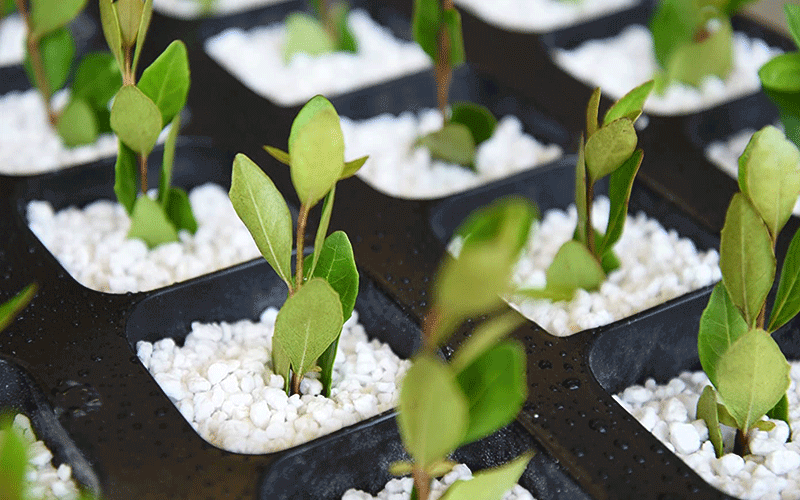Horticultural perlite benefits

Horticultural perlite benefits
When it comes to creating a soil mix for plants, there are several factors to consider. Such as the type of plant, its water and nutrient needs, and the growing conditions. Here are some general:
Drainage and Aeration. Indoor plants require a well-draining soil mix that allows for proper aeration and prevents waterlogging. Adding perlite, vermiculite, or coarse sand to the soil mix can help improve drainage and aeration.
Organic Matter. Adding organic matter to the soil mix can help improve soil structure, nutrient retention, and water-holding capacity. Compost, peat moss, or coconut coir are good options for adding organic matter to the soil mix.
Nutrients. Indoor plants require a balanced supply of nutrients for healthy growth. Adding slow-release fertilizers or organic amendments can help provide essential nutrients to the soil mix. Such as worm castings or bone meal.
pH Level. The pH level of the soil mix can affect the availability of nutrients to the plants. Most indoor plants prefer a slightly acidic soil with a pH range of 6.0 to 7.0. Adding lime or sulfur to the soil mix can help adjust the pH level as needed.
In summary, creating soil mix for indoor plants requires a balance of drainage, aeration, organic matter, nutrients, and pH level. Gardeners should consider the specific needs of their plants and adjust the soil mix accordingly.
One of the most popular substances used for soil mixture is horticultural perlite. horticultural perlite is used for both indoor and outdoor planting. In this article we are going to discuss about this useful additive.
Using horticultural perlite benefits in gardening
Using horticultural perlite benefits in gardening are numerous and include:
Improved Soil Structure. Perlite is physically stable and retains its shape, even in heavy or saturated soil. It doesn’t decompose, making it ideal for use in potting mixes for plants that are repotted infrequently, such as succulents.
Aeration and Drainage. Perlite improves the texture of heavy silt or clay soils by increasing aeration and drainage. It prevents compaction, stimulates root initiation and vigorous growth, and holds moisture without becoming soggy.
Neutral pH and Sterility. Perlite has a neutral pH level, making it suitable for any container or garden bed. It is also sterile and free from disease. making it ideal for use in plant propagation, including taking cuttings and sowing seeds.
Water Retention. Perlite can absorb water and improve drainage. making it useful for creating a free-draining potting compost for plants that need good drainage, such as cacti and succulents.
Common mistakes to avoid when using perlite in gardening
One common mistake when using perlite in gardening is adding excessive amounts of perlite to the soil mix. While perlite offers benefits such as improved drainage and aeration, using too much of it can lead to negative consequences. According to International Cannagraphic Magazine Forums, adding too much perlite, such as 25%, is considered an outdated practice. that can ruin the soil mix. Another source from Supreme Perlite mentions that excessive perlite can lead to imbalanced air and moisture conditions. which may contribute to unhealthy biological and microbial activity and increase the chances of rot.
It’s important to strike a balance when using perlite in gardening. While it improves soil structure and drainage, excessive use can lead to negative effects. Gardeners should consider the specific needs of plants and the existing soil conditions when incorporating perlite into their gardening practices.
Horticultural perlite for indoor plants
When using perlite for indoor plants, there are several key considerations to keep in mind. Here are some tips based on the search results:
Improving Drainage and Aeration. Perlite is beneficial for indoor plants as it helps with drainage and aeration. It prevents soil compaction and allows water to drain freely. which is particularly useful for plants that are prone to overwatering.
Mixing into Soil. When using perlite for indoor plants, it should be mixed into the soil to improve its structure. It can be added to potting soil to create a well-draining mix, especially for plants that require good drainage. such as cacti and succulents.
Propagation and Cuttings. Perlite is particularly useful for plant propagation, including taking cuttings and sowing seeds. It aids in creating an optimal environment for root development and seed germination.
Sterilization and Safety. When handling perlite, it’s important to protect your lungs and eyes. As it can be harmful if inhaled or if it comes into contact with the eyes. It’s also noted that horticultural grade perlite is stable. It will not degrade or compact over time, and maintains consistent aeration and drainage for plant roots.
In summary, when using perlite for indoor plants, it’s important to focus on several factors. Like improving drainage and aeration, mixing it into the soil, utilizing it for propagation, and taking necessary safety precautions.
